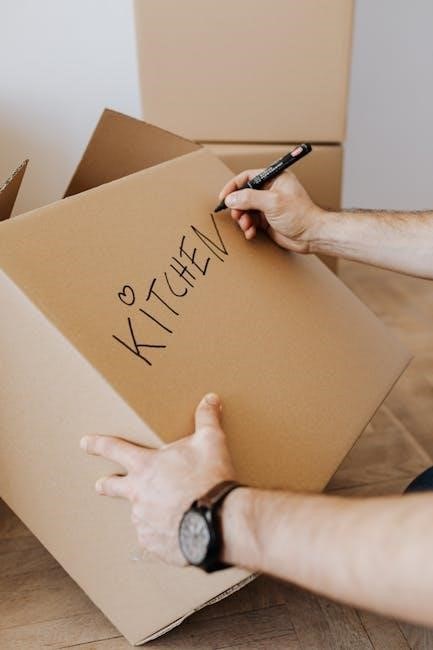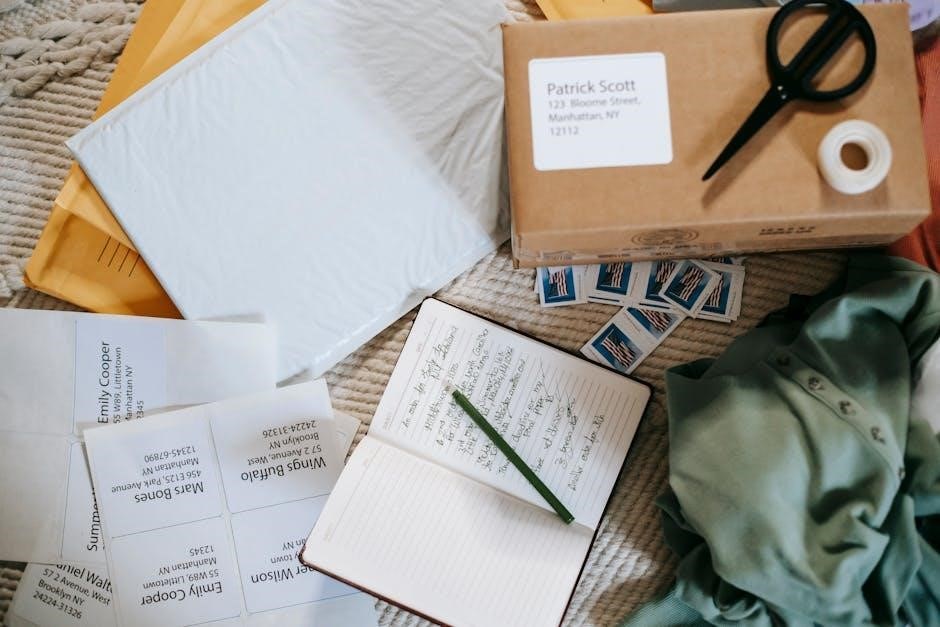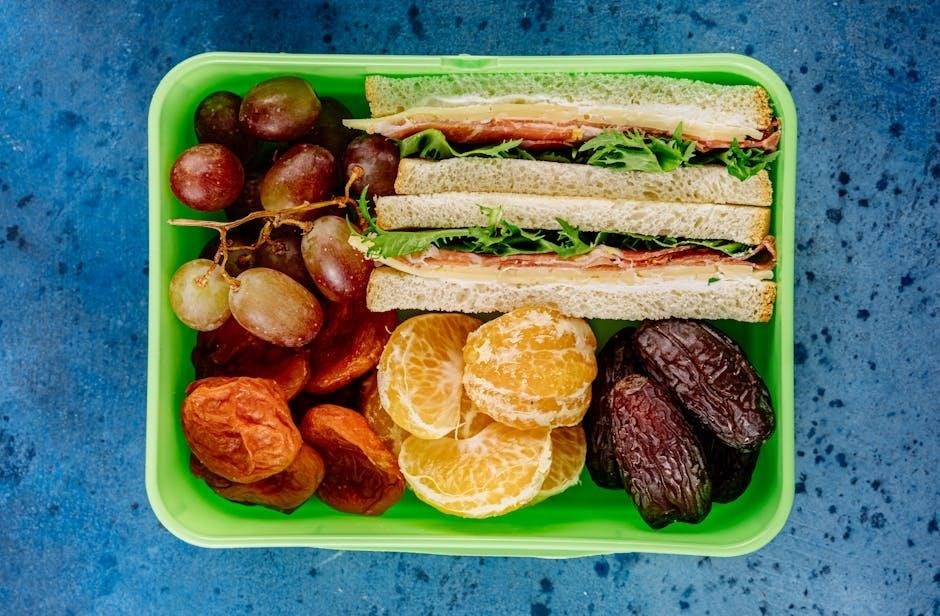Discover how to build a durable 16x20x24 plyo box with easy-to-follow DIY plans. Perfect for home workouts, this project offers a customizable, sturdy design for all skill levels.

Overview of Plyometric Training and Plyo Boxes
Plyometric training, or “jump training,” focuses on explosive movements to enhance power, speed, and agility. Plyo boxes are a cornerstone of this training, enabling exercises like box jumps, step-ups, and depth jumps. These boxes help improve vertical jump height, strength, and overall athletic performance. They are versatile, suitable for both beginners and advanced athletes, and can be adapted to various fitness levels. A well-designed plyo box, such as the 16x20x24 model, provides a sturdy, reliable surface for dynamic movements. DIY plyo box plans make it accessible to create a durable, customizable tool for home workouts, ensuring effective and safe training sessions. This approach allows users to tailor their equipment to their specific needs and fitness goals.
Importance of Proper Plyo Box Dimensions
The dimensions of a plyo box significantly impact its functionality and safety. Proper sizing ensures optimal performance for various exercises, preventing injuries and maximizing training efficiency. A 16x20x24 box offers multiple heights, catering to different skill levels and exercises. The 16-inch side is ideal for lower-impact movements, while the 24-inch height challenges advanced users. Accurate measurements ensure stability, crucial for dynamic movements like box jumps. Incorrect dimensions can lead to wobbling or poor alignment, increasing injury risks. Precise plans guarantee a box that aligns with user needs, providing a solid foundation for effective plyometric training. This attention to detail enhances both the safety and effectiveness of workouts, making proper dimensions essential for a reliable training tool.
Why Choose DIY Plyo Box Plans?
Opting for DIY plyo box plans offers numerous benefits, including customization and cost-effectiveness. With DIY, you can tailor the design to fit your specific workout needs, such as adjustable heights or non-slip surfaces. This allows for a more personalized and functional training tool. Additionally, building your own plyo box can be more budget-friendly compared to purchasing a pre-made one, especially if you already have some materials or tools on hand. The process also provides an opportunity to learn new skills and enjoy the satisfaction of creating something yourself. Furthermore, DIY projects often allow for better quality control, ensuring durability and safety. Overall, DIY plyo box plans empower you to create a customized, sturdy, and cost-effective training aid that meets your unique requirements.

Materials and Tools Required
Gather 3/4-inch plywood, 2-inch wood screws, wood glue, a saw, drill, and sandpaper. These materials ensure durability and a smooth finish for your plyo box.
Wood Selection: Plywood vs. Solid Wood
When building a 16x20x24 plyo box, choosing the right wood is crucial. Plywood is often recommended due to its cost-effectiveness, durability, and resistance to warping. Opt for 3/4-inch thick plywood, as it provides the necessary strength for heavy use. Solid wood, while sturdy, can be more expensive and prone to splitting. Plywood’s layered structure ensures stability and a smooth surface, making it ideal for a plyo box. Ensure the plywood is free of knots and imperfections for optimal performance. This choice balances affordability and durability, making it the preferred option for DIY plyo box projects.
Hardware: Screws, Glue, and Fasteners
For a sturdy 16x20x24 plyo box, the right hardware is essential. Use 2-inch wood screws to secure the frame and sides, ensuring a strong bond. Wood glue enhances joint stability, preventing shifting under stress. Countersunk screws provide a flush finish, reducing splinters. Pre-drill pilot holes to avoid wood splitting. Non-slip surfaces can be added with a clear sealer for safety. These hardware choices ensure durability and safety, making your DIY project reliable for intense workouts.
Essential Tools for the Project
Building a 16x20x24 plyo box requires the right tools for accuracy and efficiency. A circular saw or hand saw is necessary for cutting plywood to size. A drill with drill bits is needed for pre-drilling pilot holes to prevent splitting. Clamps will help hold pieces in place during assembly. A tape measure ensures precise measurements, while a square tool guarantees accurate angles. Sandpaper or a sander is essential for smoothing edges. A pencil and marker are used for marking cuts and assembly points. Safety gear like gloves and protective eyewear is crucial. Lastly, a workbench provides a stable workspace for cutting and assembling the box.

Design and Safety Considerations
Designing a 16x20x24 plyo box involves prioritizing stability and durability. Ensure the box is sturdy to withstand repeated jumps. Consider adding non-slip surfaces for enhanced safety during workouts.
Understanding the 16x20x24 Dimensions
The 16x20x24 plyo box dimensions are specifically chosen for versatility and safety. The height of 16 inches is ideal for lower-impact training, while 20 and 24 inches provide progressive challenges. The 20-inch width ensures a stable base, reducing the risk of tipping. A depth of 24 inches offers ample space for landing, making it suitable for various jump techniques. These measurements are based on standard fitness requirements, allowing users to perform box jumps effectively without compromising on safety. The size is also compact enough for home gyms, making it a practical choice for personal workouts. Proper alignment of these dimensions ensures optimal performance and durability.
Ensuring Stability and Durability
Stability and durability are critical for a reliable plyo box. Using 3/4-inch plywood ensures a sturdy structure, while 2-inch wood screws and wood glue secure the joints. Pre-drilling holes prevents splitting and aligns edges perfectly. Adding a center support reinforces the box, distributing weight evenly. This design withstands repeated jumps and heavy use. The 16x20x24 dimensions provide a stable base, minimizing tipping risks. A non-slip surface further enhances safety. Proper assembly and materials ensure long-lasting performance, making the box durable for intense workouts. These construction methods guarantee a robust and reliable plyo box for home gym use.
Adding Non-Slip Surfaces for Safety
Enhancing safety is crucial for a plyo box. Adding non-slip surfaces ensures secure footing during intense workouts. Options include applying a textured finish, attaching grip tape, or using a non-slip sealer. Sanding the surfaces smooth before applying these finishes ensures better adhesion. A clear, non-slip bathroom sealer is a popular choice, offering durability and traction. Some users also add rubber mats or abrasive strips for extra grip. These modifications prevent slipping and injuries, providing peace of mind during box jumps. Properly applied non-slip surfaces extend the box’s lifespan while maintaining safety standards for all users.

Step-by-Step Assembly Instructions
Start by cutting the plywood to size, then pre-drill pilot holes. Attach sides to the bottom with 2-inch screws and glue. Add center support for stability and durability, ensuring a sturdy structure that lasts.
Cutting the Plywood to Size
Cutting the plywood to the correct dimensions is the first step in building your 16x20x24 plyo box. Use a circular saw or a jigsaw for precise cuts, ensuring smooth edges. Measure the plywood carefully to match the required dimensions for the bottom, sides, and top pieces. Sand the cut edges to remove any splinters or rough spots. For accuracy, mark the plywood with a pencil and straightedge before cutting. A well-planned cut-list will help you organize and track each piece. Double-check all measurements to avoid errors. Properly cut pieces ensure a sturdy and professional-looking final product, making the assembly process easier and safer.
Assembling the Box Frame

Assembling the box frame is a critical step that requires precision and care. Start by interlocking the pre-cut plywood pieces according to your design. Use 2-inch wood screws and wood glue to securely attach the sides to the bottom piece, ensuring a tight fit. Pre-drill pilot holes to prevent splitting the wood and align the edges carefully. Begin by screwing the top edges first, then work your way down to maintain proper alignment. Use clamps to hold the pieces in place while screwing for added stability. This method ensures a sturdy and even frame, which is essential for the box’s durability and safety during use. Double-check all joints for tightness before proceeding to the next step.
Attaching the Bottom and Sides
Begin by attaching the bottom panel to the frame using 2-inch wood screws and wood glue. Ensure the edges align perfectly for a flush fit. Pre-drill pilot holes to avoid splitting the wood and apply even pressure while securing the panel. Once the bottom is in place, attach the side panels one at a time, starting with the front and back pieces. Use clamps to hold the sides steady while screwing them into the frame. Make sure the corners are square and the edges are flush; After securing all sides, double-check the joints for tightness and stability. This step ensures the box is rigid and ready for the next phase of assembly.
Adding Center Support for Reinforcement
Once the box frame and sides are securely attached, add the center support to reinforce the structure. Measure and cut the center support piece according to the plans, ensuring it fits snugly between the sides. Place the support in the center of the box, aligning it with the pre-measured midpoint. Use 2-inch wood screws to attach the support to the bottom panel, ensuring a tight fit. Apply wood glue to the edges for added strength. This step is crucial for preventing sagging and enhancing the box’s overall stability. Allow the glue to dry completely before moving on to the next step. Properly securing the center support ensures the plyo box can withstand heavy use and maintain its durability over time.

Finishing Touches
Complete your plyo box by sanding all edges for a smooth finish. Apply a durable sealer or paint, and ensure all components are securely attached. A final inspection guarantees safety and durability.
Sanding and Smoothing the Edges
Sanding is crucial for ensuring a smooth, splinter-free surface. Start with medium-grit sandpaper to remove imperfections, then switch to fine-grit for a polished finish. Pay attention to corners and edges, as these areas are prone to splintering. Use a sanding block for even results on flat surfaces. After sanding, wipe away dust with a tack cloth to prepare for finishing. Smooth edges can prevent injuries and ensure a comfortable grip during workouts. Proper sanding enhances both safety and durability, making your plyo box suitable for rigorous training sessions. This step is essential for a professional-quality finish.
Applying a Durable Finish or Sealer
Applying a durable finish or sealer protects the wood and enhances longevity. Use a water-resistant finish, such as polyurethane or a non-slip sealer, to ensure safety and durability. Apply evenly with a brush or roller, following the manufacturer’s instructions. Allow the first coat to dry completely before applying a second coat for maximum protection. For added grip, consider using a textured or rubber-based sealer on the jumping surface. This step prevents moisture damage and wear, ensuring your plyo box remains sturdy for years. A well-sealed finish also makes cleaning easier, keeping your box in great condition for consistent training.
Final Assembly and Quality Check
Once all components are prepared, carefully assemble the plyo box by aligning the edges and securing the sides to the bottom with screws. Use clamps to hold pieces in place while tightening. Ensure all joints fit tightly and the box is square. Conduct a thorough quality check by testing the box’s stability and weight capacity. Inspect for any gaps or loose parts, and verify that all surfaces are even and secure. Sand any rough edges or burrs for a smooth finish. Finally, ensure the non-slip surfaces are properly applied and effective. This final step ensures the box is both functional and safe for intense workouts.

Tips for Advanced Users
Explore customization options, multiple heights, and alternative materials to enhance functionality and durability, tailoring the plyo box to advanced training needs and preferences.

Customizing the Plyo Box Design
Advanced users can tailor their plyo box to meet specific training needs. Consider adding non-slip surfaces for enhanced safety or incorporating adjustable heights for versatility. Using alternative materials, such as metal or plastic, can also enhance durability. For a personalized touch, add storage compartments or customize the finish with paint or decals. Some users opt for collapsible designs for easy portability, while others integrate multiple heights into one box. These modifications not only improve functionality but also extend the box’s lifespan. By exploring creative designs, advanced users can create a plyo box that perfectly aligns with their fitness goals and preferences, making it a standout addition to their home gym setup.
Incorporating Multiple Heights
Incorporating multiple heights into your plyo box design enhances versatility for various exercises and skill levels. A 3-in-1 plyo box, featuring 16″, 20″, and 24″ heights, allows users to adjust the challenge as they progress. This design typically uses a single sheet of plywood, with cutouts that enable easy reconfiguration. By stacking or flipping the box, users can switch between heights seamlessly. This feature is particularly useful for athletes or trainers who need to accommodate different workouts or trainees. The multi-height design also saves space and reduces the need for multiple boxes. It’s a practical and efficient way to maximize the utility of your plyo box while maintaining durability and stability. This approach ensures the box remains a versatile tool for any fitness routine.
Using Alternative Materials
Exploring alternative materials for your plyo box can offer unique benefits. Metal frames provide exceptional durability and stability, while plastic or composite materials offer lightweight and weather-resistant options. For a more eco-friendly approach, consider using recycled wood or sustainable plywood. Some builders even experiment with aluminum or carbon fiber for a high-performance, professional-grade box. When using alternative materials, ensure they meet safety and weight-bearing requirements. For metal, a powder-coated finish can enhance grip and durability. Plastic boxes may require additional reinforcement for stability. These options allow customization to suit specific needs, whether for outdoor use, heavy-duty training, or aesthetic preferences; Choose materials that align with your workout goals and budget for a functional and long-lasting plyo box.

Maintenance and Care
Regularly clean and inspect your plyo box for damage. Apply a non-slip sealer to prevent wear and enhance safety. Address scratches promptly to maintain durability and performance.
Cleaning and Upkeep
Regular cleaning is essential to maintain the durability of your plyo box. Use a damp cloth to wipe down surfaces, removing sweat and dirt. Avoid harsh chemicals, as they may damage the finish or wood. For non-slip surfaces, gently scrub with a soft brush to maintain traction. Dry the box thoroughly after cleaning to prevent moisture damage. Inspect for scratches or wear and address them promptly. Applying a clear, non-slip sealer periodically can enhance safety and protect the wood. Sand rough edges if needed to ensure smooth surfaces. Proper upkeep ensures your plyo box remains safe, functional, and long-lasting for consistent workouts.
Repairing Scratches or Damage
For minor scratches, lightly sand the affected area to smooth out the surface. Deeper scratches or dents may require filling with wood filler. Once dry, sand the area until flush with the surrounding wood. After repairs, apply a durable finish or sealer to protect the wood and maintain a consistent appearance. For structural damage, inspect the joints and reinforce them with additional screws or wood glue if necessary. Regularly check for wear and tear, especially on high-impact areas, to prevent further damage. Addressing repairs promptly ensures the box remains safe and functional for workouts. Proper maintenance extends the lifespan of your plyo box and keeps it in optimal condition.
Extending the Lifespan of the Box
To extend the lifespan of your 16x20x24 plyo box, regular maintenance is essential. Start by cleaning the box frequently with a mild detergent to remove sweat and dirt, which can damage the finish over time. Avoid using harsh chemicals or abrasive cleaners, as they may strip away the protective coating. Apply a durable wood sealer or finish periodically to shield the wood from moisture and wear; Inspect the box regularly for signs of wear, such as loose screws or splintering wood, and address these issues promptly. Store the box in a dry, cool place when not in use to prevent warping or mold growth. By following these steps, you can ensure your plyo box remains sturdy and functional for years of intense workouts.
Alternatives and Variations
Explore adjustable plyo boxes for multiple heights or collapsible designs for portability. Consider metal or plastic alternatives for durability, offering versatile options for different fitness needs and preferences.
Adjustable Plyo Box Designs
For enhanced versatility, consider adjustable plyo box designs that offer multiple height options, such as 16″, 20″, and 24″. These designs allow users to customize their workouts based on skill levels and goals. Adjustable boxes often feature removable layers or mechanical systems, enabling easy transitions between heights. This space-saving solution is ideal for home gyms with limited space. Durable materials like 3/4″ plywood ensure stability, while non-slip surfaces enhance safety. Portability is another advantage, as adjustable boxes can be easily moved or stored. Whether you’re a beginner or an advanced athlete, an adjustable plyo box provides a flexible and efficient training tool for box jumps and plyometric exercises.
Collapsible or Portable Options
Crafting a collapsible or portable plyo box offers unmatched convenience for fitness enthusiasts. These designs allow easy disassembly, making them ideal for storage or transport. Constructed from lightweight yet sturdy materials, portable boxes maintain durability while being easy to move. Perfect for home gyms or outdoor workouts, they often feature interlocking pieces that simplify assembly. Non-slip surfaces ensure safety, even on uneven ground. A portable plyo box is a practical solution for those with limited space or who prefer training in various locations. With proper construction, these boxes remain stable and secure during use, providing a versatile option for any fitness routine. This design caters to athletes seeking flexibility without compromising performance or safety.
Using Metal or Plastic Alternatives
Exploring metal or plastic alternatives for your plyo box offers unique advantages. Metal frames provide exceptional durability and stability, ideal for heavy-duty training, while plastic options are lightweight and easy to clean. These materials are often more resistant to moisture and pests compared to wood. Metal boxes can be welded for strength, and plastic ones may feature molded non-slip surfaces. Both options are low-maintenance and can withstand rigorous use. However, metal may be noisier, and plastic might lack the aesthetic appeal of wood. For those prioritizing convenience and longevity, metal or plastic plyo boxes are excellent choices, offering a modern twist on traditional designs while maintaining functionality.
